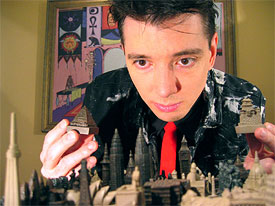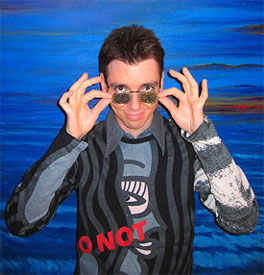About Craig Conley, the Author of Trump L'Oeil

Craig Conley is a curator, benefactor, philosopher, author, music producer, and documentarian. A former college teacher of writing and literature, he left academia to pursue his research into one-letter words, two-fold deities, and ancient technologies for using harmonics to heal and to facilitate spiritual transformations. In addition to his One-Letter Words: A Dictionary, Magic Words: A Dictionary, and Minimalist Coloring Book, he has written several educational titles, including four editions of the textbook Human Diversity: A Guide for Understanding, published by McGraw-Hill. His latest documentary, “David Lynch and His Precursors,” traces the avant-garde filmmaker’s influence through time, to movies that predate Lynch’s own body of work.

Conley is a visionary thinker. In 1999 he developed a new system of musical notation called “Do-Re-Midi,” allowing musical ideas, melody lines, riffs, arrangements, and even full scores to be easily shared via e-mail or other text-based English communication, with no special composing software or music font required. Novices can read Do-Re-Midi more easily than standard musical notation, as no more than a rudimentary familiarity with the musical scale is requisite.
Conley’s ideas are often decades ahead of their time. He invented the concept of the “virtual pet” in 1980, fifteen years before the debut of the popular “Tamagotchi” in Japan. Conley’s virtual pet was actually a rare flower that needed the proper water, light, fertilizer, and TLC in a computer game entitled “Florist.” He is pleased to report that his virtual flower is still flourishing and has in fact grown to a nearly incomprehensible size, though he cautions that “If the seed pod were to fall in the real world, we’d be facing a major catastrophe. Truly devastating.”
He resides in California and Wales.
The Tarot • The Village • The Author • The Store
|
 |
PRESS:
PRAISE:
“Miracula-filled!”
—Pam Grossman, Phantasmaphile
“Excellent and stylish.”
—Roger Langley, author of The Prisoner in Portmeirion
“Step into another world of tarot, literally. A truly unique Tarot deck from a truly unique individual.”
—Catherine Chapman, Tarot Elements
“The architecture and ornamentation of Portmeirion solidifies into a delightful three-dimensional Tarot, thanks to the quirky vision of Craig Conley.”
—Janet Boyer
“Not since Ciro Marchetti’s ‘Tarot of Dreams’ have I seen such an imaginative project, and so well presented. . . . A great deck for collectors, or for those that already have a solid Tarot base. This deck could easily be used for readings or meditation. It definitely opens up your mind!”
—Aeclectic Tarot
“The Trump L’Oeil Tarot of Portmeirion is an exciting Tarot experiment that cannot be missed in your deck collection. It’s an invitation to delve into those elements that day by day challenge us to think about the coincidences that manifest the archetypal energy contained in the world of men. Do you dare to find the archetypes that govern your life? You can see them in Portmeirion, that’s for sure.”
—NumerologySign
“Life sometimes brings us very pleasant surprises. . . . The deck itself is stunning. . . . Step out of your world for a few moments, and visit the world of Portmeirion!”
—Bonnie Cehovet, World Tarot Network
“Simply wonderful.”
—Vera Charline Wareham, author of Patchwork Faces of the Moon
“Sometimes one muses on themes around which no one has yet created a tarot—a snake tarot, a drolleries tarot, an interplanetary and so on. But over the weekend I heard of a new tarot which I could never, even in my more expansive flights of fancy, have imagined—a Tarot of Portmeirion. To many people the word ‘Portmeirion’ will mean nothing, but they will, as soon as they see photographs, nevertheless immediately recognise this village constructed down a cliffside on the coast of North Wales. It is a wonderful folly of eccentric architecture created from 1925 onwards by the Welsh architect Clough Williams-Ellis. Well known as a tourist site in Britain, it came to international prominence through being the setting for the 1967 surrealistic television series The Prisoner which starred Patrick McGoohan. Now Craig Conley has created a tarot deck based on his photographs of architectural features from Portmeirion. In the world of tarot someone always trumps one's imagination by invisaging a deck which one could never have thought up oneself.”
—Adam McLean, The Artwork of Modern Tarot
“I love that a village can be so saturated with archetypal symbolism that Tarot images (as the author and photographer says) ‘pop up’ as one wanders through it. It is not unusual for me to see Tarot images as I go about my daily life, but all 78 and all clustered in one place? Delightful, delicious, delovely! As to how these Portmeirion images work as a Tarot deck? Quite well, I believe, though some knowledge of Tarot might be helpful. Unless one reads very intuitively, then this deck would work absolutely fine. Each [photograph] seems clearly suitable as a Tarot image, yet at the same time offers something unique.”
—Patricia Kelly, Roswila’s Tarot Gallery and Journal
“The set of cards is very detailed, imaginative, and features some lovely images of Portmeirion.”
—Rick Ravy, The Unmutual
“The Tarot deck is well made. The photographs for each of the Major Arcana and the four suits are striking. The book that accompanies the deck is engaging and fun to read.”
—Fredrick Turner, Magic and Conjuring
“I have just been reviewing the companion book for Craig Conley’s “Trump L’Oeil: Tarot of Portmeirion”. I love the deck, which is based on the eccentric village of Portmeirion in Wales. The art, statues and architecture in this village are a fantasy world of thier own — every turn, every corner brings something unexpected. The companion book offers full-color photos for all 78 cards, along with a short interpretation for the Major Arcana cards. The really unique thing about this book is that each card is based on a particular structure or piece of art within the village, and a map that locates the art is included with each card. It is possible to visit this village; with this book, it is also possible to locate the inspiration for each card.”
—Bonnie Cehovet
|
 |